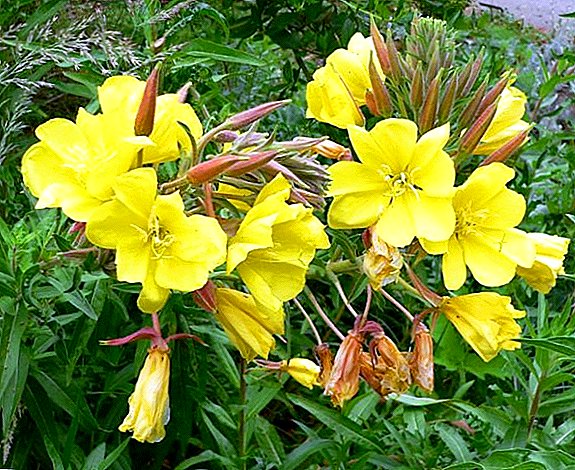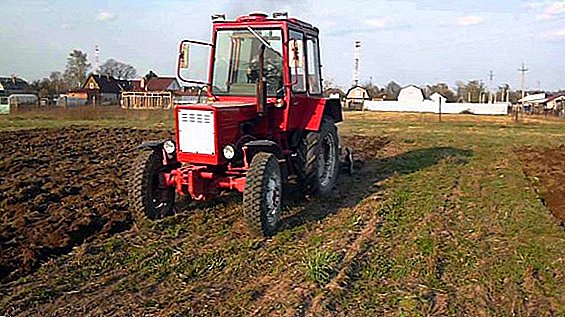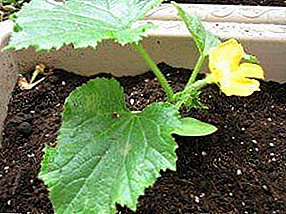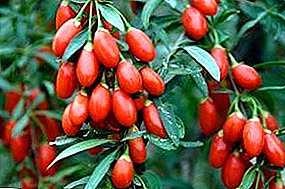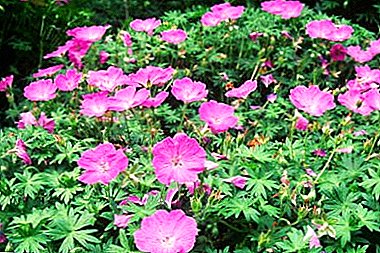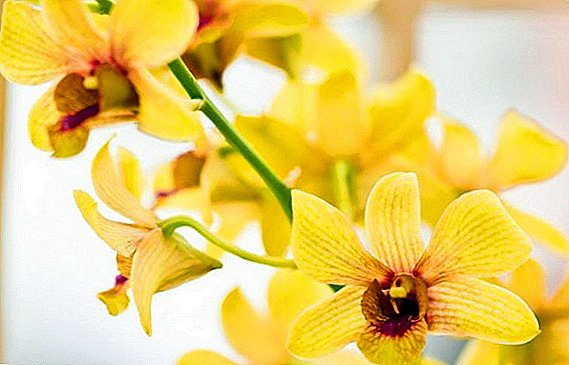 Due to its beauty and variety of color orchid dendrobium are very popular among gardeners.
Due to its beauty and variety of color orchid dendrobium are very popular among gardeners.
This article will tell you the difference between different types of these flowers and how to properly care for them at home.
Dendrobium nobile (noble)
It is considered one of the most spectacular species. Large plant with fleshy straight stems, which are characterized by a glossy sheen. It reaches a height of 50 - 60 cm. The flowers appear in the second year (two or three on one peduncle) and are pleased with the bright coloring, the effect of which is enhanced by the characteristic aroma. Hybrids can produce color several times a year.
The flowers themselves are quite large (from 4 to 10 cm). Their white "edging" on the bottom half is complemented by a purple, violet or purple tip. The petals themselves have an ovoid shape with elongated sepals.
Dendrobium noble came to us from the Himalayas. There it grows on mountain slopes and is distinguished by white-purple petals. His popularity among domestic flower growers, he owes his relative unpretentiousness.  For the successful maintenance of such a plant at home will require:
For the successful maintenance of such a plant at home will require:
- stable air temperature (at least 15-18 degrees of heat in winter);
- intense light. The scattered flow is necessary, periodically the flower needs to be lighted up with a lamp.
- prepared soil. Many prepare a mixture of peat with coal and particles of chopped moss. Also suitable and ready-made mixture, which can be purchased in specialized stores.
- drainage and watering. Moisture needs are moderate, but water needs to be held up a bit (they cope with it, covering the soil with moss).
Important! "Fresh" bulbs are not flooded when watering - this leads to rapid decay.
In the case of the dendrobium nobile, the description will be incomplete without a story about the transplant. Experts do not advise to get involved in such a measure, although in some cases it is done annually. If you can see that the orchid has already become cramped in a pot, then it is better not to hurry - wait until the flowering period ends. Also, do not take up the "relocation" of the flower with small pseudobulb sizes. There are also urgent cases. Finding that the soil is saline, immediately grab the transplant.
 The breeding process can be "adjusted." It is simple: the old bulb is divided into parts and placed in warm water for 2 to 3 hours, after which they start drying. In about three weeks of such manipulations, appendages appear.
The breeding process can be "adjusted." It is simple: the old bulb is divided into parts and placed in warm water for 2 to 3 hours, after which they start drying. In about three weeks of such manipulations, appendages appear.
As you can see, everything is simple, even for a novice grower. Therefore, such a dendrobium flower can be the beginning of a collection.
Dendrobium Phalaenopsis
The natural habitat is Southeast Asia. In our latitudes represented by a variety of hybrids. Due to this, the species is striking variety. Coloring - from white to rich lilac and dense violet. It sounds tempting, but the choice of plants must be approached with knowledge of the case.
Did you know? Its name (Phalaenopsis) genus was due to optical illusion. Observing the twilight of the jungle, Karl Blume took these orchids for a flock of white moths. Understanding his mistake, the scientist suggested that this name be left (from the Gr. "Similar to the moth").
Even before going to the store is to decide what kind of flower is needed. The miniature type can not grow to 30-35 cm, while the standard ones, with proper care, "blow out" up to a meter in height.
Separately focus on the options with blue colors. Rich blue color should be alerted. The fact is that some sellers inject in the flower stalks the paint, which creates the appropriate shade. To distinguish such a "product" can be on the characteristic notches. Yes, and a similar color for such a plant as dendrophalenopsis, is not typical. There are sky-blue varieties, but for our latitudes it is exotic, available only to "advanced" amateurs.  Having made a purchase, you can expect the following. The size of the flowers ranges from 2 to 15 cm (depending on the hybrid). Periods of flowering usually occur three times a year. With constant care, flowers (up to 40) may not fall off for several weeks.
Having made a purchase, you can expect the following. The size of the flowers ranges from 2 to 15 cm (depending on the hybrid). Periods of flowering usually occur three times a year. With constant care, flowers (up to 40) may not fall off for several weeks.
To admire this beauty, you need to provide the following conditions:
- Daylight should last at least 12 hours. Direct rays cause burns on the leaves, so that no diffused light is complete. If there was no other place, except on the south window, it is necessary to create a shadow artificially.
- Humidity. It is desirable daily spraying in the morning. And no batteries under the pot! It is possible to increase the humidity by laying out the bottom of the pallet with expanded clay and pouring water there. At the same time the pot itself is not put water.
- Watering depends on the season. In the summer it can be once in two - three days, in the winter it is enough and once in two weeks. You should not be zealous with water, nor should you allow excessive drying of the substrate. The bark should soak up enough water. Another point - phalaenopsis is still a tropical plant, and too cold water is contraindicated to it. Tap water is not always suitable, so flower growers use distilled.
- Before fertilizer required watering. So the plant will not get burned. The leaves are fertilized by spraying from the inside (the drug must be diluted in a proportion of 1/6 of the usual dose).
Important! For fertilizer orchids use only liquid fertilizer. Preparations in the form of tablets or sticks only harm the roots.
 To replant dendrobium phalaenopsis is recommended no more than once every 2-3 years. His roots are fragile. During transplantation, dried and rotten roots are cut, and the incision is covered with charcoal. The new "place of residence" should be a transparent pot that is filled with pieces of bark and moss. Leave 3-4 cm from the edge - when the air roots appear, they will also have to be powdered.
To replant dendrobium phalaenopsis is recommended no more than once every 2-3 years. His roots are fragile. During transplantation, dried and rotten roots are cut, and the incision is covered with charcoal. The new "place of residence" should be a transparent pot that is filled with pieces of bark and moss. Leave 3-4 cm from the edge - when the air roots appear, they will also have to be powdered.Dendrobium Moniliform
He is the "younger brother" of the noble dendrobium. We most often have small plants of this species (reaching 15-20 cm), but in their natural environment they are much larger.
The species is cultivated in Japan, which led to its rather high cost. True, this does not frighten the real grower, especially since the flower does not require any special delights in the content.
Did you know? The National Park of Singapore presents more than 60 thousand orchid species.Mostly come across specimens with white-lilac leaf color. Pleasant fragrant flavor is another argument in favor of such an acquisition. Representatives of this variety of dendrobium orchids can bloom all year round (usually from February to September).
 When the plant has reached 5 cm in height, it is ready to bloom. Flowers appear - white, with a pink shade closer to the tips. Each bulb is able to give 1-2 inflorescences.
When the plant has reached 5 cm in height, it is ready to bloom. Flowers appear - white, with a pink shade closer to the tips. Each bulb is able to give 1-2 inflorescences.Everything you need to know about the care of such exotics:
- Direct sunlight is safe, moreover - several hours in this mode are required for moniliform. Pros recommend placing it on the west side.
- Humidity does not matter in principle, although it is not necessary to bring it to extremes, and it is better to look after the soil.
- The substrate for disembarking is prepared loose, light, capable of passing air and water. It is advisable to use a special orchid soil.
- Watering boils down to abundant "baths" two or three times a week.
Dendrobium densely colored
Another guest from Southeast Asia. There, these orchids grow on moss-covered trees, less often on rocks. Both in the natural environment and on the windowsills the sizes are in the range of 30-45 cm.
The flower belongs to the so-called group (thanks to the multifaceted bulbs with thick ligaments). They are able to produce up to one hundred peduncles, and in the inflorescence there will be from 50 flowers to 100. The color of the flower is yellow, with hues ranging from oily-saturated to light.
Such a dendrobium is a variety of orchid, exuding a fragrant odor within one to two weeks of flowering. This phenomenon reaches its peak in April and May, although the gap between February and the beginning of September is considered “classic” for this variety.  In terms of agrotechnics, the variety is distinguished by the following requirements:
In terms of agrotechnics, the variety is distinguished by the following requirements:
- Support ambient light at a daytime temperature of 25-27 degrees above zero (at night - from 17 to 19);
- In winter, watering is rare, in the warm season - plentiful (in summer and at least once a day). During growth, the substrate must be wet, and during maturity new shoots are already allowed to dry.
- Soil: loose and drying substrate.
Important! To prepare the substrate used bark of dead trees. So gather up material in the nearest park is unlikely to succeed.
- Fertilizer is made at the rate of 0.5 dose of the "orchid" composition. In the spring and in June, nitrogen-containing compounds are useful, and closer to autumn, phosphorus-containing supplements are useful.
- Transplantation takes place every couple of years. Obsolete flowers and dry sheets are cleaned.
Dendrobium King
Australian variety. The stem reaches 30-55 cm, the bulb is the same size. Peduncles usually produce from three to seven small flowers (1 to 3 cm in diameter). The flowers are kept for a month, emitting a pleasant vanilla smell. It happens in the first half of the year (the peak is in March). Such a dendrobium is a minimum of hassle in the cold season. With all its thermophilia, this orchid has a long dormant period.  Other features related to care:
Other features related to care:
- Room temperature: from + 14-15 ° С at night to + 23-24 in the afternoon. Sustain "for thirty" can also, but it is better not to abuse it.
- Requires powerful ventilation.
- The soil should dry out. Top dressing in winter is significantly reduced (up to the termination).
- Transplant is done immediately after flowering time. The plant painlessly transfers division into increments.
Dendrobium Parisha
The representative of the Asian highlands. Differs brilliantly pink color of the flower. Single flowers 5–6 cm in size appear on the stems. The flowering period is small, from one and a half to two weeks, and takes place from April to June. In some hybrids, this period is shifted to the calendar spring and summer.  In order for such a miracle to please the eye, we must remember that:
In order for such a miracle to please the eye, we must remember that:
- It is desirable to keep the difference between day and night temperatures within 4-10 degrees (in the daytime +27, at night - not less than 17). Extreme temperatures are +35 in summer and +10 in winter;
- Bright sunlight is needed. Direct rays are not terrible, but when they are exposed, the leaves seem to "fade", becoming covered with red or purple specks.
- The substrate is prepared at the rate of 1/3 of the moss pot, the rest is bark and peat. You can keep on the blocks, but then you have to water daily in the morning;
- Water "Asian" need warm (30 - 35 degrees) with water;
- There is no need for frequent transplants, except in case of saline soil. Sprouts transplanted when they reached 5 cm and began to build up the root.
Dendrobium is beautiful
Almost all types of orchids; dendrobium names are not distinguished by an impressive stem. This orchid is an exception. Stem 7 cm for such plants is vital, because they come from Eastern Australia, some varieties come across in Asia. Long and thick leaves grow almost at the very top.
The flowers on the inflorescences appear twice a year: in the spring and on the "transition" from summer to autumn. 2,5- and 3-centimeter flowers are pleased with a stunning aroma. The first summer months and winter the plant spends in hibernation.  Features:
Features:
- Lands on the blocks;
- Requires sunlight;
- It develops well, being in the open air.
Dendrobium fringed
Remarkable for its height. Standard indicators for this class are from 0.6 to 1.2 meters, although there are instances of 1.8 meters in height.
Externally recognizable by long (8 - 15 cm) leaves, walking in two rows at once. Peduncles carry flowers from 4 cm in diameter each, there may be up to fifteen of them. The flowering period - the whole year with a peak in the spring months. Flowers hold up to ten days, with a slightly sour smell. Not much, but this is partly offset by abundant flowering. 
Did you know? On one of the plants of this species 1216 flowers were counted, ascended on 123 peduncles.Features of care:
- Summer temperature content from +21 (minimum at night) to +31 (daily maximum). Not recommended to drop more than 9 degrees. Winter figures - from +9 to +19, respectively, with the same differential;
- Average illumination;
- Maintain moisture during growth, watering is reduced in autumn. In nature, such plants tolerate a semiannual drought, but for their indoor "fellow" it is unacceptable.
- Both blocks and substrates are suitable for maintenance (any breathable one will do);
- Regular feeding. Once a week, fertilizers are applied in a dosage of ¼ - ½ of the usual volume for orchids. In the warm season, these are drugs with nitrogen, in the fall - phosphorus-containing.
- Transplant at any time of the year, after the "launch" of new roots;
- In winter, let the soil dry out, but not to the state of the stone. Between irrigation procedures during the rest period, the orchid is periodically sprayed.
Dendrobium long-horned
Recognized by the sharp, spaced around the circumference of the flower leaves. Alpine plant, which is rarely found in domestic growers. Short flowering period - up to three weeks in the first half of spring. The flowers themselves reach sizes of 6 cm with an average height of the whole plant of 25 cm.  Differs unpretentiousness and a long period of rest. The requirements for care are the same as for other orchids: light and abundant watering in the months of growth and "controlled drying" of the substrate during the cold season.
Differs unpretentiousness and a long period of rest. The requirements for care are the same as for other orchids: light and abundant watering in the months of growth and "controlled drying" of the substrate during the cold season.
Dendrobium primrose
Unusual in color "densely populated" orchid. Multi-leaf shoots with a lot of ligaments give their effect during flowering - flowers (4 - 8 cm in diameter) with a yellow-white lip, which is framed with purple stripes.
In their range (Southeast Asia), these orchids bloom in February-March, while hybrid varieties - from the beginning of the year to the end of summer. As with many Asians, direct sunlight is dangerous for the primrose. Abundant watering (every three days during growth) and soil condition monitoring are desirable.  In winter, for successful maintenance, additional lighting is needed (about four hours a day). The rest of the care is standard for plants of this species.
In winter, for successful maintenance, additional lighting is needed (about four hours a day). The rest of the care is standard for plants of this species.
In this article, we reviewed the features of the most common types of dendrobium. Hopefully, now orchids, their types and care at home do not represent a special mystery to our readers, and former favorites will be pleasing to the eye with their colorful blooms.


